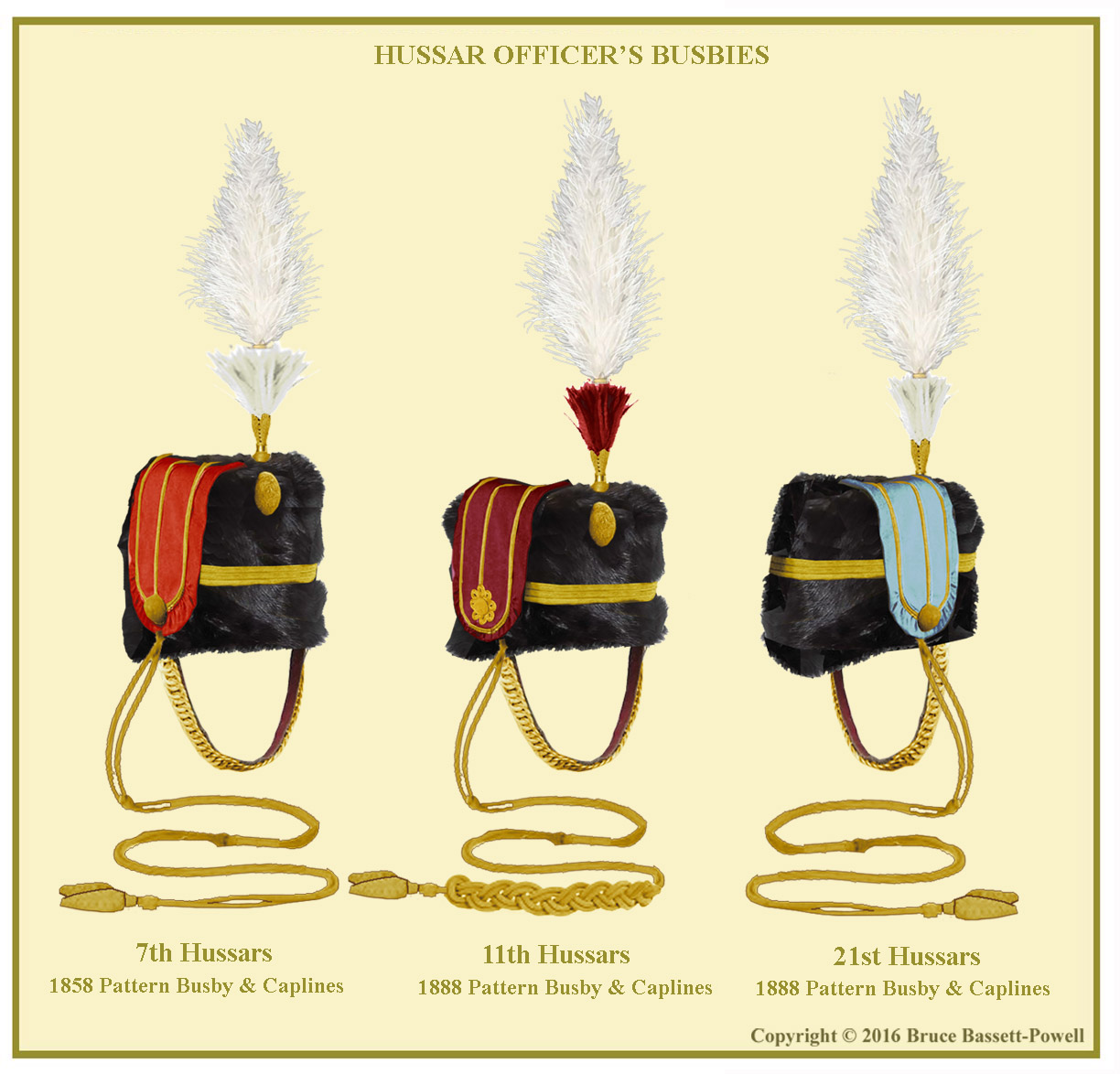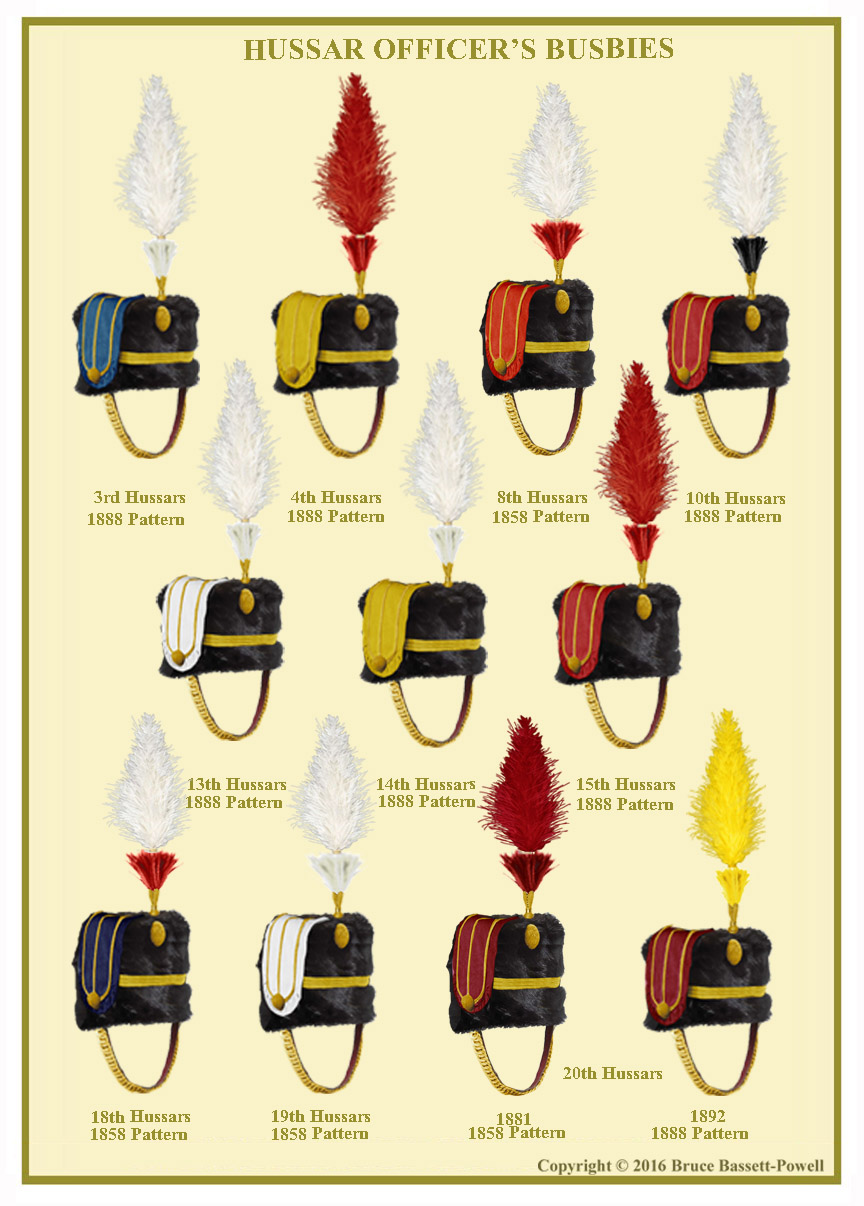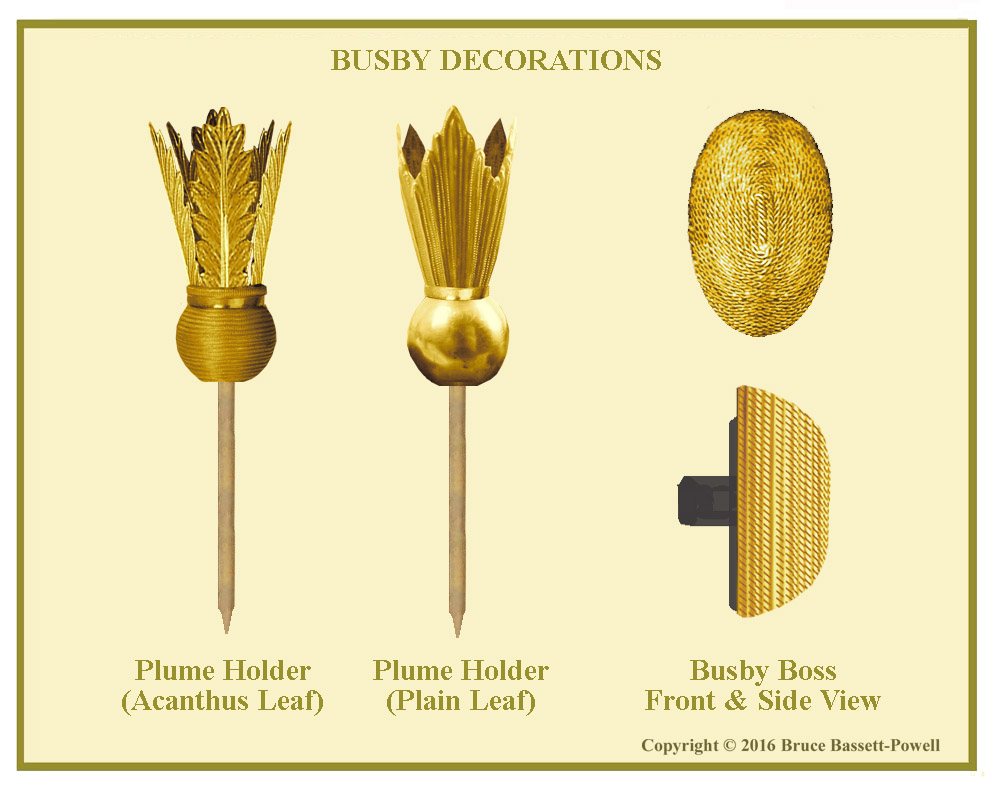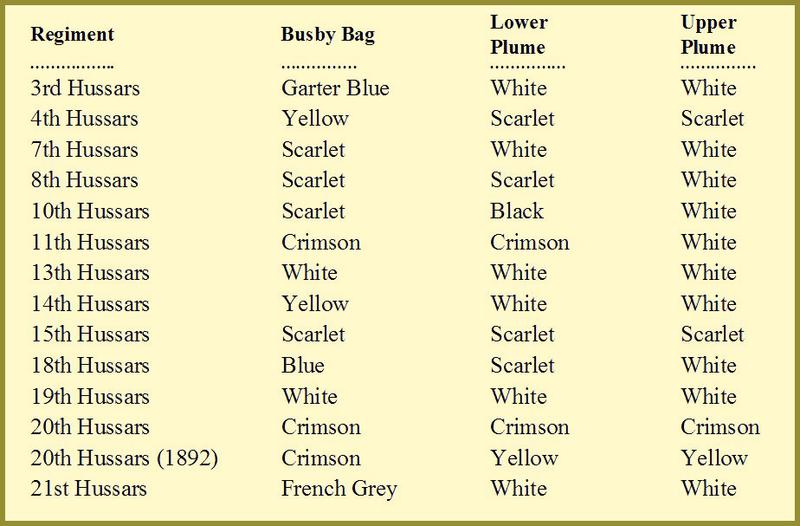UNIFORMS, ARMS & EQUIPMENT - HUSSARS
THE HUSSAR REGIMENTS IN 1881
OFFICERS' FULL DRESS HEADDRESS
In 1881 hussar officers wore the pattern of busby introduced in 1858. Made of black sable fur, it was 7 ¾ inches high in front, 9 inches at the rear and 8 inches on the sides. The top of the busby to be ½ inch less in diameter than the bottom which was shaped to fit the head. An oval cockade or boss of gold gimp spiral cord, 2 inches high and 1½ inches wide, was worn on the front of the cap level with the top. The back of the boss had a spring socket to hold the stem of the plume. There was a coloured cloth bag, covering the top of the cap and falling down the right side to within an inch from the bottom. A gold gimp cord edged the bag (about ½ inch from the edge) with a length of cord going down the middle meeting the edge cord at the bottom of the bag. At the junction of the cords a small gold gimp boss.
The plume consisted of coloured egret feathers measuring 9 inches from the top of the cap. A ring circled the lower part of the plume with the feathers below the ring cut shorter than above. Some regiments have the lower part differently coloured than the upper part. The feather was inserted into a ball socket with upright gilt leaves. The ball was fitted with a wooden stem that slid into the spring socket behind the cockade. The curb chain was made of dead and bright gold corded chain lined with black morocco leather.
In 1888 the dimensions of the busby were ordered to be changed (Army Order 33). It was lowered in height to 6¼ inches in front to 7 ¾ inches in the back, with the sides altering accordingly. The bag now was to reach within a ½ inch of the lower edge. The egret feather plume was also to be 13 inches tall.
In the 1900 regulations the plume was to be of ostrich feathers with a separate part at the base made of vulture feathers. The overall plume to be 15 inches tall.
The caplines (originally designed to keep the headdress with the rider should it fall off the head),
Were of gold purl cord which, passing through a ring behind the bag, went round the body of the cap three times then around the neck looping onto the breast with olivets on the ends.
The 3rd (King’s Own) Hussars
Raised 1685 as Dragoons. Light Dragoons in 1818 and Hussars in 1861.
The 4th (Queen’s Own) Hussars
Raised 1685 as Dragoons. Light Dragoons in 1818 and Hussars in 1861.
The 7th (The Queen’s Own) Hussars
Raised 1689 as Dragoons. Light Dragoons in 1784 and Hussars in 1807.
The 8th (King’s Royal Irish) Hussars
Raised 1693 as Dragoons. Light Dragoons in 1775 and Hussars in 1822.
The 10th (Prince of Wales’s Own) Hussars
Raised 1715 as Dragoons. Light Dragoons in 1783 and Hussars in 1806.
The 11th (Prince Albert’s Own) Hussars
Raised 1715 as Dragoons. Light Dragoons in 1783 and Hussars in 1840.
The 13th Hussars
Raised 1715 as Dragoons. Light Dragoons in 1783 and Hussars in 1861.
The 14th (King’s) Hussars
Raised 1715 as Dragoons. Light Dragoons in 1776 and Hussars in 1861.
The 15th (The King’s) Hussars
Raised 1759 as Light Dragoons and Hussars in 1807.
The 18th Hussars
Raised 1858 (Took traditions and battle honours of old 18th Hussars disbanded in 1821).
The 19th Hussars
Raised 1857 as 1st Bengal Light Cavalry. On British establishment as Hussars in 1862
The 20th Hussars
Raised 1857 as 2nd Bengal Light Cavalry. On British establishment as Hussars in 1862
The 21st Hussars
Raised 1857 as 3rd Bengal Light Cavalry. On British establishment as Hussars in 1862
Converted to Lancers in 1897
The details of the plumes, bags and other differences between regiments are below.
For the 10th Hussars, the caplines did not go round the neck, but down the back, under the arm and across the body to the base of the collar before looping up to the right shoulder. The 7th Hussars had not, from the 1840s looped their caplines to the right shoulder but left the acorns drop from the neck. The 11th Hussars had caplines that were plaited from the neck to the shoulder. Also there were eight small gold lace loops around the busby bag button. The 14th Hussars had no busby boss on the front and in the 15th Hussars, the caplines did not go round the busby but straight to the back of the neck. Photographs of the 21st Hussars in Egypt in 1896 shows them with plaited capline ends like the 11th Hussars.
Photographic evidence shows that hussar officers generally wore their headdresses according to regulations. Allowing plume lengths to comply with regulations was often an impossible task with plume lengths varying considerably, especially before the 1891 regulations. The 11th Hussars had worn a brown fur busby since 1857 and it was probably worn well into the eighteen eighties.






